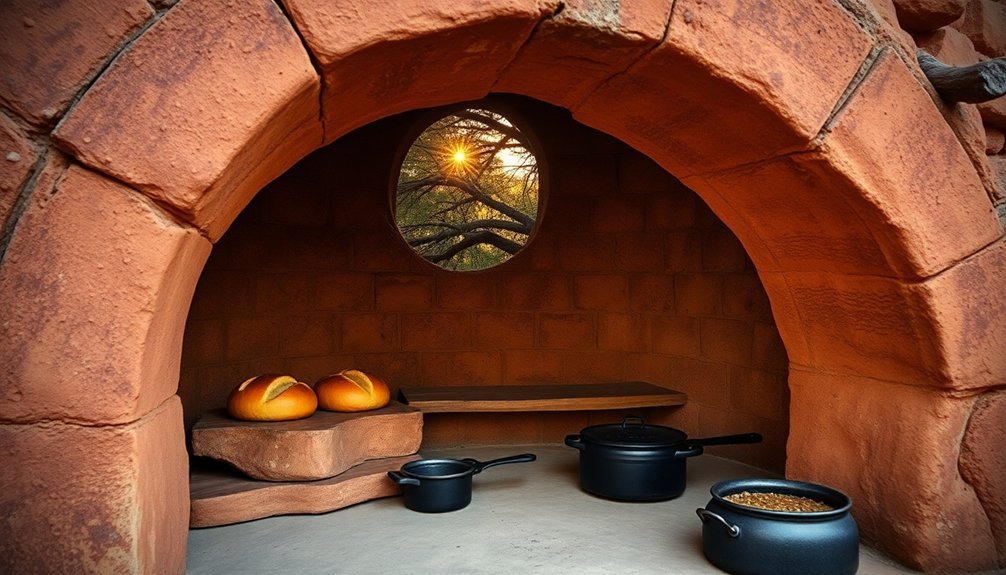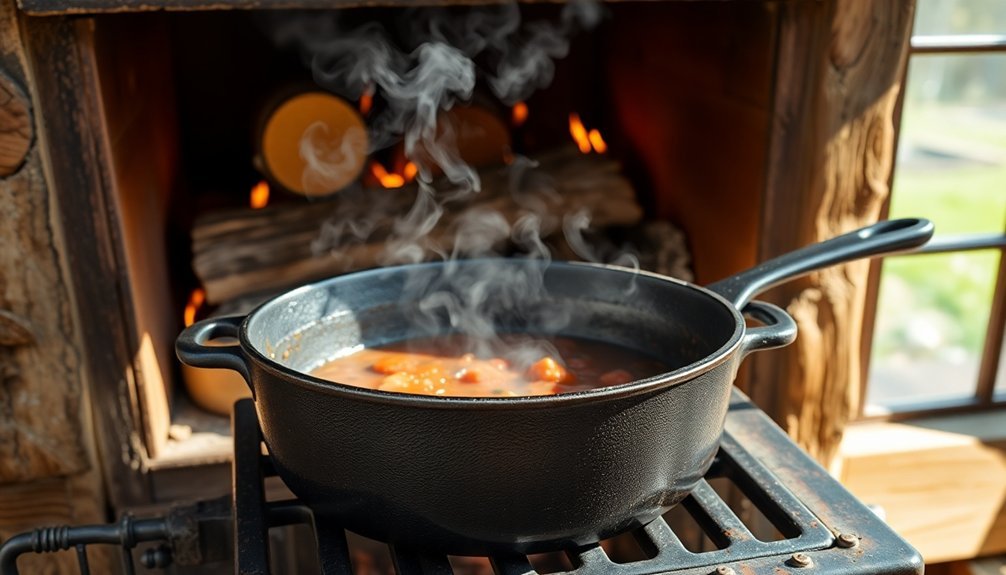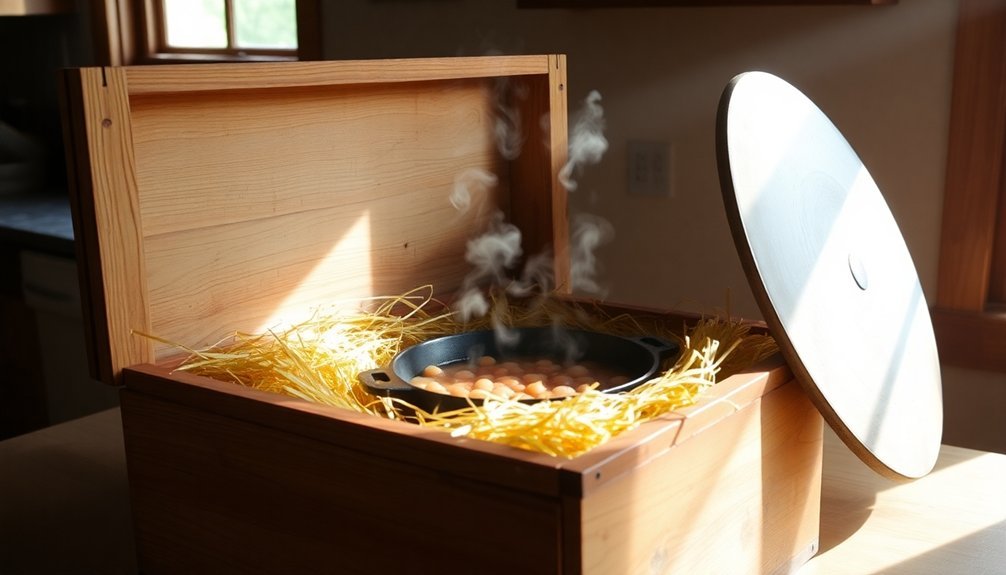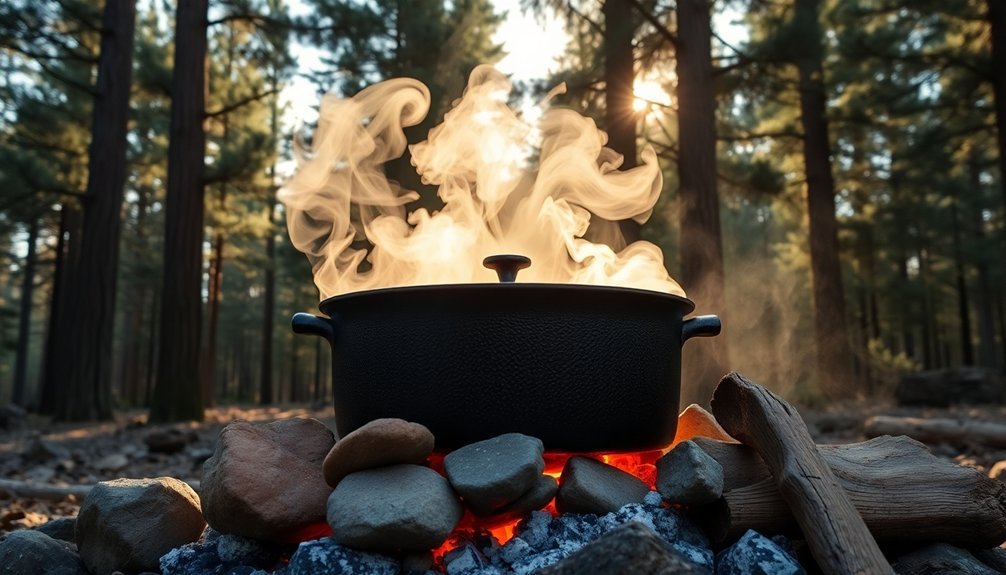You can cook off-grid with five proven methods that don't require modern utilities. Build an earth oven from clay and rocks for efficient heat retention, or harness the sun's power with a solar cooker equipped with reflective surfaces. Master wood stove cooking by controlling airflow and temperature, while utilizing cast iron Dutch ovens for versatile meal preparation. For energy-free slow cooking, try the hay box method using insulation to retain heat after initial boiling. Each technique offers unique advantages, from baking bread to simmering stews, and you'll discover how these ancient practices can transform your approach to sustainable cooking.
Earth Oven Essentials

While primitive in appearance, earth ovens are marvels of thermal engineering that combine simple materials with clever design principles.
You'll need clay, earth, or cob for the main structure, along with gravel and flat rocks for insulation. The igloo-like dome shape, secured by rock-wedge construction, maximizes heat retention and airflow. The entrance should be 60 percent height of the total oven dome for optimal performance.
You can fuel your earth oven with readily available materials like sticks, wood, or small twigs. The thick walls absorb and radiate heat efficiently, keeping your oven hot for over six hours after the fire's out.
You'll achieve perfect results through the combined power of radiation, conduction, and convection, creating evenly baked foods with crisp crusts.
Best of all, you're cooking sustainably using local materials and renewable resources, making this an ideal solution for off-grid living.
Solar Power Your Kitchen
Moving from earthen heat to celestial power, solar cooking harnesses our most abundant energy source.
You'll need a solar oven equipped with reflective surfaces that concentrate sunlight into a cooking chamber lined with metal and topped with glass.
For best results, set up your solar cooker between 11:00 am and 3:00 pm, positioning it directly toward the sun. Always maintain safe viewing distance when checking your solar cooker to protect your eyes.
You'll find cooking times are longer than conventional methods, but you can prepare everything from stews and casseroles to baked treats.
Use a transparent cover like a plastic bag or glass bowl to trap heat effectively.
Choose your cooker type based on your needs: box cookers for general cooking, parabolic designs for grilling, or panel cookers for rice and vegetables.
Remember to adjust the reflectors periodically and always use a thermometer to guarantee food safety.
Wood Stove Cooking Basics

Learning to cook on a wood stove combines three essential elements: fire management, temperature control, and cookware placement.
Start by clearing the ash grate and building your fire with tinder and kindling, then gradually add larger wood pieces. You'll control temperature through the airflow vents – more air creates hotter fires, while less air reduces heat. Using well-seasoned local wood ensures optimal heat output and efficiency.
For effective cooking, preheat your pans and use cast iron cookware for even heat distribution.
Position pans on the stove's sweet spot for faster cooking or move them to cooler areas to keep food warm. The oven typically needs 45 minutes to reach 350°F, while the firebox works well for coal cooking.
You can also use the warming box for proofing bread or maintaining food temperature. Remember to adjust airflow controls based on your specific cooking needs.
Mastering The Dutch Oven
The Dutch oven stands as one of the most versatile tools for off-grid cooking, building upon the principles of heat control we explored with wood stoves.
You'll find its thick cast iron walls retain heat exceptionally well, allowing you to cook efficiently using minimal fuel. Camp-style ovens feature short legs and raised lid rims specifically designed for outdoor cooking.
To master Dutch oven cooking, you'll need to understand coal placement. For baking, use twice as many coals on top as bottom, and arrange them in a ring pattern rather than directly underneath.
Start by searing your ingredients in hot oil, then layer flavors by deglazing with wine or broth. You can even use the lid as a temporary holding dish while you work.
For best results, elevate your Dutch oven with a trivet in windy conditions, and remember to let it cool naturally before cleaning to prevent damage.
Hay Box Heat Retention

While modern cooking methods rely heavily on constant fuel consumption, hay box cooking harnesses the simple power of heat retention to prepare meals efficiently. You'll only need enough fuel to bring your food to a boil before transferring it to an insulated container where it continues cooking for several hours.
To create your hay box, you can use traditional materials like straw and newspaper, or opt for modern alternatives such as polystyrene and emergency blankets. The key is maintaining thick insulation around a tightly sealed pot that's nearly full. You'll want to verify your container is well-sealed to trap heat effectively.
For safety, always reheat your food to a boil before eating, as bacterial growth can occur if temperatures drop into the danger zone. This method's perfect for stews, soups, and off-grid situations.
Frequently Asked Questions
How Long Can Food Safely Stay Warm in a Hay Box Cooker?
You'll find your food stays safely warm for 4-8 hours in a haybox cooker, maintaining temperatures above 140°F. Remember to check with a thermometer and reheat to boiling before eating for safety.
Can Solar Ovens Be Used Effectively in Cold but Sunny Weather?
Yes, you'll find solar ovens work effectively in cold weather when there's bright sunshine. They can reach 200-300°F regardless of outside temperature. Just make sure you position it correctly and cook between 11 am and 3 pm.
What Woods Should Be Avoided When Cooking Over an Open Fire?
You'll want to avoid softwoods like pine and cedar, resinous woods, driftwood, and processed woods. These can release toxic substances, create excess smoke, burn too quickly, and potentially contaminate your food.
How Do You Prevent Rust on Cast Iron Cookware in Humid Environments?
Keep your cast iron dry immediately after washing, apply a thin oil coating before storage, use paper towels to absorb moisture, guarantee proper air circulation, and store in a cool, dry place away from humidity.
Are Propane Stoves Safe to Use Inside Tents During Bad Weather?
No, you shouldn't use propane stoves inside tents. They create deadly carbon monoxide and pose fire risks. Even in bad weather, you'll need proper ventilation – cook under a separate tarp or shelter instead.
In Summary
You'll find that off-grid cooking isn't just about surviving – it's about thriving with sustainable methods that connect you to traditional food preparation. Whether you're digging an earth oven, harnessing the sun's power, or mastering your Dutch oven skills, you're joining a movement that's both environmentally conscious and deeply satisfying. Start with one method and expand your off-grid cooking toolkit as you grow more confident.





Leave a Reply